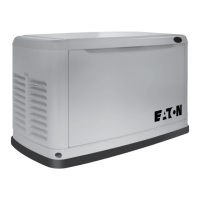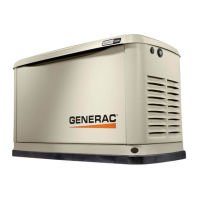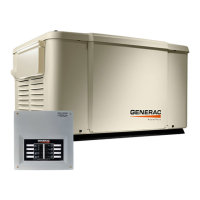GENERAL INFORMATION
PART 1
Page 27
INTRODUCTION
When the Generator is installed in conjunction with a transfer
switch, either manual or automatic operation is possible.
See Section 5.1 for the manual transfer and engine startup,
manual shutdown and re-transfer, and full automatic operation
procedure.
UTILITY FAILURE
Initial Conditions
The Generator is in AUTO, ready to run, and the CONTACTOR
is in the “Utility” position. When Utility fails (below 65% of
nominal), a 10-second line interrupt delay time is started. If
the Utility is still not present when the timer expires, the engine
will crank and start. Once started a five (5) second engine
warm-up timer will start.
When the warm-up timer expires the controller will transfer load
to the Generator. If Utility voltage is restored (above 75% of
nominal) at any time between the initiation of the engine start
and when the Generator is ready to accept load, (five second
warm-up time has not elapsed), the controller will complete the
start cycle and run the Generator through its normal cool down
cycle; however the CONTACTOR will remain in the “Utility”
position.
CRANKING
The controller will cyclic crank the engine 5 times as follows: 16
second crank, 7 second rest, 16 second crank, 7 second rest
followed by 3 additional cycles of 7 second cranks followed by
7 second rests.
Choke Operation
•The 990/999cc engines have an electric choke in the air box
that is controlled automatically via the controller.
•The 530cc engines have an electric choke on the divider
panel air inlet hose, control is done automatically via the
controller
•The 410cc engines have a choke behind the air box. Control
is done automatically via the controller.
Failure to Start
Failure to start is defined as any of the following occurrences
during cranking.
1. Not reaching starter dropout within the specified crank
cycle.
Note: Starter dropout is defined as 4 cycles at 1,000RPM
2. Reaching starter dropout, but then not reaching 2200 rpm
within 15 seconds. After which the controller will go into
a rest cycle for 7 seconds, then continue the rest of the
crank cycle.
Note: During a rest cycle the start and fuel outputs are de-
energized and the magneto output is shorted to ground.
CRANKING CONDITIONS
The following notes apply during the crank cycle.
1. Starter motor will not engage within 5 seconds of the
engine shutting down
2. The fuel output will not be energized with the starter
3. The starter and magneto outputs will be energized
together
4. Once the starter energizes, the controller will begin looking
for engine rotation. If it does not see an RPM signal within
3 seconds it will shut down and latch out on “RPM Sensor
loss”
5. Once the controller sees an RPM signal it will energize
the fuel solenoid, drive the throttle open, and continue
the crank sequence. The fuel solenoid does not activated
earlier because if the engine does not crank, this would
potentially fill the engine/exhaust up with fuel. It takes
at least 3 seconds to detect cranking on the engine with
a magneto RPM measurement. This would result in 3
seconds of fuel being delivered, increasing the chances of
a backfire.
6. The starter motor will disengage when speed reaches
starter dropout
7. If the Generator does not reach 2200 rpm within 15
seconds, re-crank cycle will occur.
8. If the engine stops turning between starter dropout
and 2200 RPM the board will go into a rest cycle for 7
seconds then re-crank (if additional crank cycles exist.)
9. Once started the Generator will wait for a hold off period
before starting to monitor oil pressure and oil temperature.
See Section 4.2 “Engine Protective Devices”
10. During a manual crank attempt, if the AUTO-OFF-MANUAL
is switched from MANUAL position to OFF, the crank
attempt will abort.
11. During automatic crank attempt, if the Utility returns,
the cranking cycle does NOT abort, but continues until
complete. Once the engine starts, it will run for one
minute then shut down.
LOAD TRANSFER PARAMETERS
The transfer of load when the Generator is running is dependent
upon the operating mode as follows:
Manual
•No transfer to Standby when Utility is present.
•Transfer to Standby will occur if Utility fails (below 65% of
nominal) for 10 consecutive seconds.
•Transfer back to Utility when Utility returns for 15 consecu-
tive seconds. The engine will continue to run until removed
from the Manual mode.
Section 1.7
Automatic Operating Parameters

